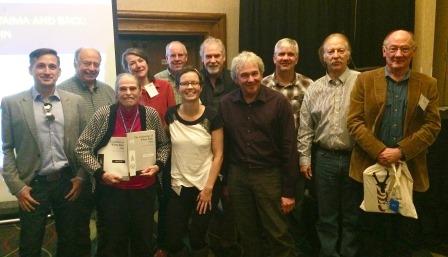The symposium summary (Great Basin Conference Program, See October 18 Entries) described Dr. Gruhn's career with more than fifty years of active fieldwork, research, and teaching, from River Basin Survey projects such as Wakemap Mound and Priest Rapids on the Columbia River through to her Ph.D. at Radcliffe, and on to extensive travel and research with her late husband, University of Alberta Emeritus Professor the Alan L. Bryan. Together, they traversed the western hemisphere advocating for the early arrival of First Nations and Native Americans in the New World, with a particular focus on Central and South America.
Professor Gruhn's 1961 dissertation research at Wilson Butte Cave documented one of the earliest archaeological sites in western North America, while providing a lengthy stratigraphic record throughout prehistoric time. It became-and remained-a point of reference for much subsequent archaeological work in Idaho. A number of speakers addressed Ruth's role as a model for them as both a scholar and person, and especially her pioneering work in overcoming the barriers women faced in pursuing archaeological careers in the 1950s and 1960s.
In the photo are Professor Gruhn, Dr. Jack Ives (Landrex Distinguished Professor, back centre), and University of Alberta PhD candidate Gabriel Yanicki, both working in the Promontory caves in Utah. Also present are symposium organizers Dan Meatte (second from right) and Suzi Pengilly (third from left, back row), as well as University of Alberta PhD Loren Davis (third from right, now Associate Professor at Oregon State University). Ives and Yanicki are both also working in the Great Basin, in the Promontory caves of Utah (Apachean Origins Research at the Institute of Prairie Archaeology).
In October 2013 in Santa Fe, Professor Gruhn was similarly honoured at the Paleoamerican Odyssey conference, attended by more than 1100 archaeologists, geneticists, linguists, geologists and avocational archaeologists. Professor Gruhn's two part account of her own career appeared in Volumes 28 (4) and 29(1) of the Mammoth Trumpet, published by the Center for the Study of the First Americans, Texas A & M University.
